
views
Lucknow: As SP-BSP and Congress go all guns blazing in Uttar Pradesh ahead of the crucial Lok Sabha battle, the Bharatiya Janata Party (BJP) has more or less remained mum on its game plan, triggering questions about its counter strategy to beat the opposition.
Officially, BJP leaders speak about 'mission 73 seats' and focusing on 50% plus vote share in the state. However, the question that they don't answer is how they intend to proceed towards their target.
While the saffron party hopes that the subtle Hindutva move through deliberations on Ayodhya Temple and emphasis on development and welfare schemes will work in its favour, the actual electoral arithmetic is being tried through management of the caste equations.
As party chief Amit Shah is set to hold a rally in the state, News18 decodes BJP's strategy on the basis of caste dynamics.
Amid the rising agrarian distress and menace of stray cattle, caste is probably the only hope for the BJP, and this time, non-Yadav OBCs and non-Jatav Dalits have become the deciding factor.
"At the moment, while Yadavs have consolidated behind the Samajwadi party, Jatavs among the Dalit have mostly aligned with the BSP. With the coming together of SP and BSP, these two most dominant and biggest castes of the backwards and Dalits seem to have entirely distanced themselves away from the BJP," said professor Prashant Trivedi of Giri Institute of Development Studies.
Also the Jats in West UP are reported to have moved towards its original turf of the RLD. With RLD now being in an alliance with SP-BSP, it will be a cause of concern for the BJP.
In 2014 Lok Sabha polls and then in 2017 assembly polls, BJP had managed to make a significant dent in both the Yadav and the Jatav castes. However, this time the alienation from the saffron party seems complete. Thus, the possible grazing ground left for the BJP is naturally the non-Yadav backwards and the non-Jatav Dalits.
Experts say that out of 21% of Dalit vote share in the state, around 56% is the Jatav with maximum concentration in the West UP. The second biggest Dalit caste is Pasi with maximum concentration in Awadh and central UP. The other Dalit and the most backward classes are scattered across districts.
Backward castes are estimated to be around 54% of the total population. Yadavs form the biggest chunk of it, followed by the Kurmis. With the Yadavs supporting the SP-BSP alliance, BJP has now put its force behind Kurmis.
Its efforts at reaching out to Rajbhars in the east is also well-known. Prime Minister Narendra Modi was himself in Gazipur recently to launch a postal ticket in the memory of Raja Suhel Deo Rajbhar.
Kurmis dominate the region of Awadh and sizeable pockets of the east UP, specially around the region of Varanasi, Chandauli and Mirzapur. Varanasi is also the parliamentary constituency of Prime Minister himself.
Among the Dalit castes, BJP is focusing on the Pasis, specially in the region of Awadh. The party also has some prominent Pasi faces like Kaushal Kishore, the sitting MP from Mohanlalganj. Now, it is working overtime to keep Pasi support in its favour.
Pasi as a caste had shifted political loyalty over the decades. Being with Congress till 80's, it had been then with BSP for long, before moving to the SP. But since 2014 it had been with the BJP.
The BJP, over the past few months, had done series of caste conferences. Though they largely went unnoticed by national media, on the ground it was seen as serious effort by the BJP to keep its non-Yadav, non-Jatav base intact.
Interestingly, it was party's backward face, Deputy Chief Minister Keshav Prasad Maurya, who was most vigorously involved with them. Maurya is another influential backward caste, having strong presence in the Doab region of the Ganga-Yamuna Basin. That is the belt, which comprises Phulpur, Allahabad, Pratapgarh and pockets of Rai Bareli
UP BJP spokesperson Rakesh Tripathi, however, denies these Caste considerations. "Yadavs or Jatavs are not hostage to any party. BJP has a strong presence among them. However BJP doesn't work on caste lines. Like 2014 and 2017, the party will get support across spectrum."
But ground realities show it's not that easy for the BJP this time around. The stray cattle issue had emerged as a major crises that has adversely affected the castes cutting across the political lines. Even the Upper castes have felt the heat.
Though it's also a fact that much bigger reason of upper caste annoyance had been the ammendement in the SC/ST act . BJP has, however, tried to dilute the annoyance by implementing the 10 percent Quota for the economically deprived upper castes.
But coming back to cattle menace and the agrarian crises issue, question is can BJP manage it through its caste maneuverings or else the economic distress will see new unity of the castes on the ground.
P Krishna Prasad, the national treasurer of the All India Kissan Sabha, claims that farmers across states, specially in UP have started to emerge as a class. "It is uniting over the issue of agrarian crises and will stand united against the BJP," he said.
There are still a couple of months to polls. Till then this non-Jatav, non-Dalit votebank remains a keenly contested one among the BJP and the opposition. How these caste vote will decide the fate of all, specially the BJP.



















Comments
0 comment